Well, I Got Some Free Pie!
Farmington (Google Maps Location)
September 29, 2007
The Stanley-Whitman House is a National Historic Landmark and is also on the Connecticut Historic Gardens Trail.
This is it. It took me 32 museums and probably 100 CTMQ write-ups altogether to get to this point – and let me preface this by stating that the Stanley-Whitman House is a lovely, well-presented, and very enjoyable museum. It’s just that my visit was altered by the massive distraction that only a cranky toddler can supply. So the point is – I will be cribbing nearly 100% of this report from the various handouts I received while there as well as from their website. And it’ll happen again, I assure you. Besides, it’s an old colonial house museum; one of 200 or so in the state. I think we’ll all survive.
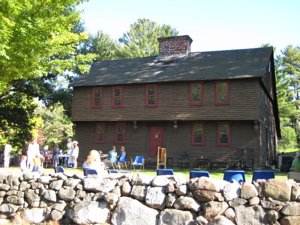
So perhaps I can say that this report will be unique from the others because I wasn’t able to be focused on my tour? That, and it contains the absolute worst pictures yet! Yeah, that’ll be my “angle.” Just go with it… It’ll be fun!
I had passed by the Stanley-Whitman a week or two prior, finding a shortcut to a car spot along the nearby Metacomet Trail which we’re hiking end to end. At that time I noticed a little sign in front of the house advertising an upcoming Family Day at the museum, which stuck with me.
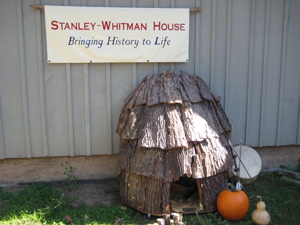
That day came and since it was beautiful outside and because we live only a short distance away, we gave it a shot. The Stanley-Whitman is located in the small historic section of Farmington that people bring their out-of-town relatives to when they say, “Show me ‘New England’!” There are several historic buildings and the little village area is beautiful.
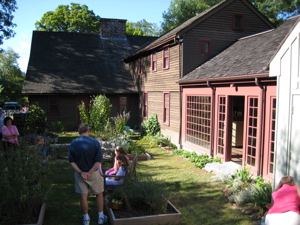
Aside from the more famous nearby Hill-Stead Museum, there is also Miss. Porter’s School which is where wealthy young women go to learn how to speak with affected rich-girl New England accents. It is my duty to also mention that one Ms. Jackie Bouvier Kennedy Onassis attended Miss Porter’s; although I can’t imagine her traipsing back from Starbucks in flip-flops and low-rise sweatpants with her belly exposed, as it appears is de rigueur at the school these days.
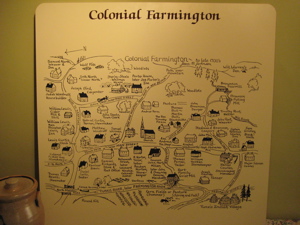
Anyway, we parked and happened upon a very large happening at the museum. About 100 or so folks were dressed in colonial costume in front of the house doing colonial things. Hoang mumbled something about there being an inordinate amount of white folks here – just before we were greeted by a very nice Asian lady as we stepped onto the museum grounds.
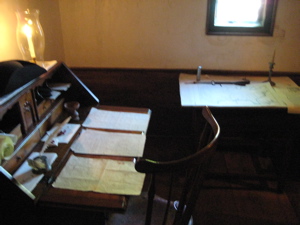
She offered us all sorts of options and things to join, but we declined as CTMQ is really only interested in the true museum experience. We entered the museum and I immediately noted how incredibly new this old house appeared. Before I could investigate, we were all offered free pie! Apparently colonialists enjoyed pie baking competitions and we were able to sample some of the, ahem, fruits of their labor. None of them wowed me, but I was hardly complaining. Free pie!
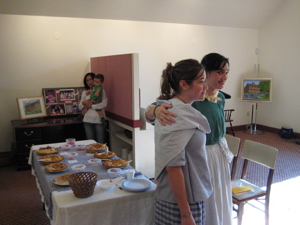
Note Damian discreetly in the background (no idea who these random young women are) pointing for some free pie.
Here’s the deal: The house was built in the early 1700’s and today’s model stands on the same spot – with the original frame being all that is, well, original. The house is constructed in the colonial New England overhang style of architecture. Much investigation was undergone to restore the house to its original specifications – beginning in 1980 and lasting until 1988. They’ve done a fine job.
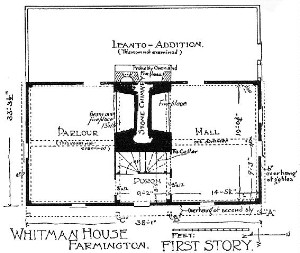
Back in 1725, a Mary Steel (whose father Ebenezer had purchased the original dwelling house from Deacon John Stanley) married a Thomas Smith and they became the first of a succession of newlyweds to occupy and raise their children in the house. This begins the rough time period that the museum attempts to recapture; which runs through 1772 when Solomon and Susannah Cole Whitman lived there. Members of the Whitman family lived in the house until 1922.
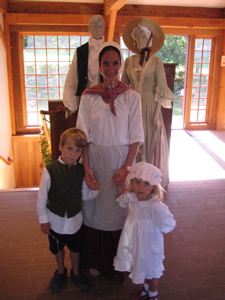
Random colonial family
Both families were financially well-off and while both were Puritans and farmers, the men of the house knew other trades like blacksmithing, weaving, and shoemaking. The women, among other skills, were adept at baby-making.
A bit about the house proper:
As was typical of the day, a center chimney was flanked by parlor and hall with two chambers above for storage and sleeping. The construction was of posts and beams joined with wooden pegs, creating a frame which was then covered with wooden clapboards. The second floor extends beyond the first, creating an overhang – original purpose unknown. Later, an addition gave the house its “saltbox” shape.
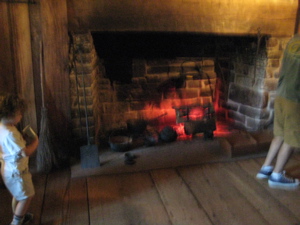
From the moment we arrived, our little Damian was being fussy. I poked around while Hoang tried to occupy him, but was intercepted by a kindly old docent who offered to give me a tour. It turned out that I couldn’t tour the joint myself, unfortunately. I asked her for the sped up condensed version and she agreed. That didn’t necessarily mean she’d adhere to this, though.
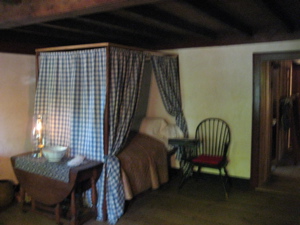
After sloooowly putting on gloves, she guided me to the kitchen. There was a giant hearth. Off the kitchen, we walked through the lean-to garret. Not added until 30 years or so after the house was built, it contained stored grains and drying vegetables and such. My guide was keen to point out each. And. Every. Carrot as we poked along.
I wasn’t too sure if I was allowed to snap pictures, so I was doing it on the downlow. No flash and quickly when my guide wasn’t looking. But again, we’ll have a chance to see this same stuff down the CTMQ road I’m sure of it. We saw a few more rooms; a parlor room, another room with a hearth for heating, a room with a loom and weaving tools in it, another with old furniture and things.
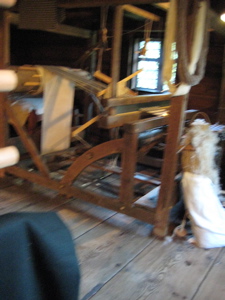
By now, Hoang was out on the lawn with Damian and I could see them through the windows as I went from room to room. Hoang’s face was saying, “Okay buddy, hurry up.” An office with old desk furniture and a kid’s room… Listen, this place is very nice and they’ve done a phenomenal job with the restoration and all the research (the booklet I picked up details this for several pages) and my tour guide informative and wonderful, but I got it – The Stanley-Whitman House is a lovely peek into 18th century Farmington life. Visit; it’s beautiful.
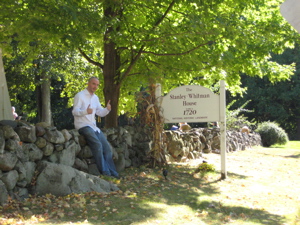
I told my guide I simply had to attend to my wife and child and took leave of her. I quickly checked out the nice herb and vegetable garden in the back and then wound my way to the front to meet up with my family.
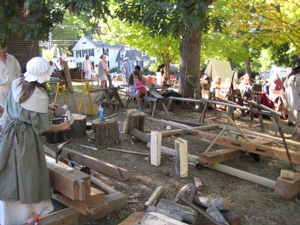
![]()

 honeybunny says
honeybunny says
December 17, 2007 at 1:09 pm“I told my guide I simply had to attend to my wife and child and took leave of her.”
How Olde English of you ~~
Be of good cheer Steveth.
hb
 A curious girl says
A curious girl says
November 12, 2009 at 3:15 amI would love to go to this Stanely-Wihitam house! It looks very interesting. I loved the website, thanks for putting it!
 Linda Shea says
Linda Shea says
March 23, 2014 at 2:52 pmThank you for your hard work & dedication on this great project! I’m related to the Stanley’s , John & Sarah Scott Stanley. Another piece of information is that the mother of John Stanley is Ruth Werden,married to John Stanley(May 18, 1624), in Ashford, Kent County, England.Ruth was born May 28, 1600 in Ashford, Kent, England. She died circa 1630-1632. He then married Elizabeth Inlenden/ golden on April 19, 1632 Thank you again for the History. ~Linda